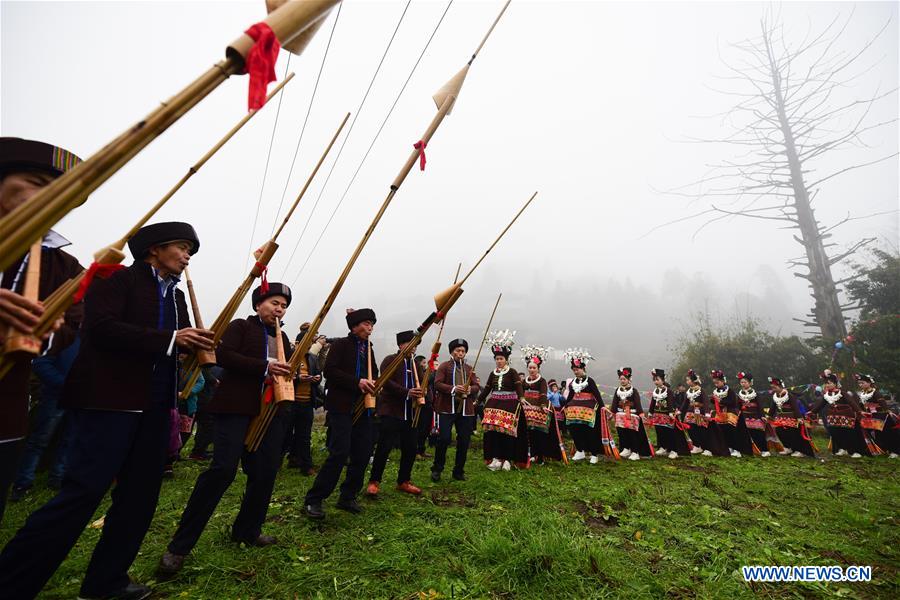Miao People
Location
Primarily in southern China (Guizhou, Hunan, Yunnan), and spread to Vietnam, Laos, and Thailand.
History
The Miao are an ancient people, believed to have migrated south from the Yellow River basin around 4,000 years ago, developing a unique culture through continual adaptation.
Culture
・Textiles and Embroidery:::Famous for intricate handwoven clothing, especially among women.
・Silver Ornaments:Lavish silver accessories worn during festivals.
・Music and Dance:Reed-pipe instrument (lusheng) performances and group dances.
・Agriculture:Terraced rice fields, corn farming, and traditional agricultural life.
Miao Symbols and Flag
No official national flag
but symbolic motifs includ
・Phoenix:Symbol of luck and rebirth.
・Butterfly:Represents life and origin (Miao mythology speaks of a butterfly mother creating humans).
・Silver Accessories:Indicators of status and celebration.
Language
Miao Language Features
・Language Family:Hmong-Mien (Miao-Yao) language family.
・Phonetics:
・Extremely tonal: 6 to 8 distinct tones.
・Rich system of vowels and consonants.
・Writing:
・Originally oral tradition with no writing system.
・Now written using the Pollard script and Latin alphabet systems.
・Characteristics:
・Tone is crucial: different tones completely change meanings.
・Significant regional dialect differences, especially within China.
Common Miao Greetings and Phrases
| English | Miao Language (Hunan Dialect Example) | Pronunciation |
| Hello | Ntxoov zoo | Nor-joe |
|---|---|---|
| Good morning | Muaj peev | Moo-bay |
| Thank you | Ua tsaug | Wah-bee-ah |
| Nice to meet you | Tos zoo | Taw-yao |
| Good night | Nyo siab | Yao-shen |
| Delicious | Tsau qab | Tsah-bao |
| Fun/Enjoyable | Zoo siab | Hao-zoo |
Notes
・Ntxoov zoo can mean both "hello" and "how are you?"
・Regional variations are common in Miao language expressions.
Region
Continent: Oceania
Region:Primarily in southern China (Guizhou, Hunan, Yunnan), and spread to Vietnam, Laos, and Thailand.
Access Guide
Karen People
Example Routes from Major Cities to the Homeland of the Karen People (Myanmar / Thai Highlands)
| Departure City | Direct/Transit | Arrival Airport | Flight Time (approx.) | Reference Fare (one-way/round-trip, Economy) |
| Los Angeles | LA → Beijing or Shanghai → Guiyang | Guiyang Longdongbao (KWE) | 15–20 hours | US$900–1,300 |
|---|---|---|---|---|
| New York | NY → Beijing or Shanghai → Guiyang | Guiyang Longdongbao (KWE) | 17–23 hours | US$1,100–1,600 |
| London | London → Beijing or Shanghai → Guiyang | Guiyang Longdongbao (KWE) | 17–22 hours | £700–1,000 |
| Tokyo | Tokyo → Shanghai or Beijing → Guiyang | Guiyang Longdongbao (KWE) | 7–10 hours | ¥70,000–120,000 |
| Sydney | Sydney → Guangzhou or Beijing → Guiyang | Guiyang Longdongbao (KWE) | 13–18 hours | A$950–1,300 |
| Hong Kong | Hong Kong → Guiyang | Guiyang Longdongbao (KWE) | 2.5–3 hours | HK$1,200–2,000 |
| Shanghai | Shanghai → Guiyang | Guiyang Longdongbao (KWE) | 2.5–3.5 hours | CNY 900–1,400 |
| Singapore | Singapore → Guangzhou or Shanghai → Guiyang | Guiyang Longdongbao (KWE) | 7–10 hours | S$450–650 |
Note: The traditional homeland of the Karen people covers northern Thailand and eastern Myanmar, but for visitors, Chiang Mai (Thailand) is generally the most accessible entry point.
Origin and Writing of Miao Language
Miao language belongs to the Hmong-Mien (Miao-Yao) family.
Ancestors likely migrated southward from the Yellow River basin over 4,000 years ago.
Miao language may even predate Old Chinese in certain linguistic layers.
Writing Systems
・Traditionally Oral: Cultural memory passed through songs and storytelling.
Pollard Script:
Developed in the early 20th century by missionary Samuel Pollard; uses innovative combinations of vertical and horizontal marks.
Latin Alphabet Systems
Widely adopted since the 1950s for ease of education and literacy.
Chinese Characters:
Rarely used, except for names or place names in adapted forms.
Key Points
・OriginExtremely ancient, pre-dating much of Han China
・FamilyHmong-Mien language family
・TraditionOral transmission without early writing
・Current ScriptsPollard script and Latin-based alphabets
・Tone Usage6–8 tones essential to word meaning
Traditional Games of the Miao People
1.Lusheng Dance (Reed-Pipe Dance)
・Description:Playing lusheng (reed-pipe instrument) while dancing in circles.
・Purpose:Celebration, matchmaking, and community bonding.
2.Miao Pitch-Pot (Throwing Arrows into a Jar)
・Description:Throwing small arrows into a jar from a distance.
・Purpose:Tests concentration and accuracy.
3.Miao Chicken Chase
・Description:Children chase chickens during festivals.
・Purpose:Agility and festive joy.
4.Tug-of-War Competitions
・Description:Large-scale team contests.
・Purpose:Strength-building and communal fun.
Introduction video


The Miao people's language, vibrant arts, and traditional games showcase their resilience, creativity, and deep-rooted connection to nature and community.
